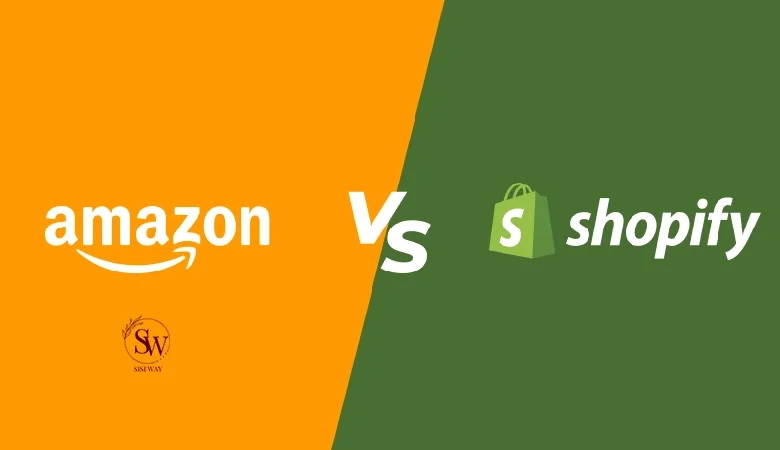Shopify vs. Amazon: Which Platform is Better for Selling Online?

In the rapidly evolving landscape of e-commerce, entrepreneurs are faced with a crucial decision: where should they set up shop to maximize their sales potential? With giants like Shopify and Amazon dominating the market, it’s essential to weigh the pros and cons of each platform to determine which aligns best with your business goals. In this comprehensive analysis, we delve into the intricacies of selling on Shopify versus Amazon, exploring key factors such as control, branding, fees, audience reach, and scalability.
Control and Branding:
When it comes to control over your brand and customer experience, Shopify holds a significant advantage. With Shopify, merchants have full autonomy to design their online store according to their brand identity. From customizing website aesthetics to creating personalized marketing campaigns, sellers can tailor every aspect of their storefront to resonate with their target audience. This level of control fosters brand loyalty and credibility, as customers associate the unique storefront with a sense of professionalism and authenticity.

In contrast, selling on Amazon entails relinquishing a certain degree of control over branding. While Amazon provides a massive platform with unparalleled reach, sellers operate within the confines of Amazon’s marketplace. This means adhering to Amazon’s guidelines and policies, which may limit the extent to which sellers can differentiate their brands. Additionally, product listings on Amazon tend to follow a standardized format, making it challenging for sellers to stand out amidst competitors.
Fees and Cost Structure:
One of the primary considerations for any online seller is the fee structure imposed by the platform. Shopify operates on a subscription-based model, offering various pricing tiers to accommodate businesses of all sizes. Merchants pay a monthly fee ranging from $29 to $299, depending on the features and functionalities they require. In addition to the subscription fee, Shopify charges transaction fees for each sale, which range from 2.9% + 30¢ to 2.4% + 30¢, depending on the selected plan.
Amazon, on the other hand, utilizes a different fee structure, primarily consisting of referral fees and fulfillment fees for sellers utilizing Fulfillment by Amazon (FBA). Referral fees vary by product category, typically ranging from 6% to 45% of the item’s selling price. FBA fees encompass storage fees, fulfillment fees, and optional services such as labeling and prep services. While Amazon’s fee structure may appear complex, it’s essential to consider the potential cost savings associated with leveraging Amazon’s vast customer base and fulfillment network.
- Amazon:
- Individual Plan: If you choose the Individual plan on Amazon, you’ll be charged 99 cents for every item you sell.
- Professional Plan: The Professional plan costs $39.99 per month.
- Shopify:
- Monthly Subscription: Shopify operates on a subscription model. You’ll pay a monthly fee, which varies based on the plan you choose. The pricing ranges from $39 to $399 per month.
- Transaction Fees: If you use Shopify Payments, there are no transaction fees. However, if you don’t use Shopify Payments, the transaction fee can be between 0.5% and 2%, depending on your plan.
- Additional Costs: Unlike Amazon, Shopify doesn’t charge extra fees for listing or selling products. You only pay the subscription fee.
In summary, while Amazon charges a referral fee for each item sold, Shopify’s fees are primarily based on its subscription plans. Consider your business needs and preferences when choosing between these two platforms!
Audience Reach and Exposure:
Amazon reigns supreme in terms of audience reach and exposure, boasting over 300 million active customer accounts worldwide. As the largest online marketplace, Amazon offers unparalleled visibility to sellers, allowing them to tap into a vast pool of potential customers. Furthermore, Amazon’s robust search algorithms and recommendation engine optimize product discoverability, increasing the likelihood of conversion for sellers.
While Shopify may not match Amazon’s reach, it provides sellers with the tools to drive traffic and expand their customer base through various marketing channels. From social media integration to email marketing campaigns, Shopify empowers sellers to engage with their audience and drive targeted traffic to their online store. Additionally, Shopify offers built-in SEO features and integrations with third-party apps to enhance visibility and attract organic traffic.
Scalability and Flexibility:
Scalability is a critical consideration for businesses looking to grow and expand their operations over time. Shopify offers scalability in abundance, with scalable pricing plans and a robust infrastructure capable of supporting businesses of all sizes. Whether you’re a small startup or an established enterprise, Shopify scales alongside your business, providing access to advanced features and integrations as your needs evolve.
Amazon also offers scalability through its Fulfillment by Amazon (FBA) program, which handles order fulfillment, shipping, and customer service on behalf of sellers. By leveraging Amazon’s fulfillment network, sellers can efficiently manage inventory and fulfill orders, allowing for seamless expansion into new markets and territories. Additionally, Amazon offers advertising solutions such as Sponsored Products and Amazon Stores to help sellers increase visibility and drive sales.
Shipping
Shopify and Amazon are both powerful platforms for selling online, but they serve different purposes. Let’s break down their key features and compare them:
- Shopify:
- Platform Type: Website builder and host.
- Functionality: Shopify allows businesses to build their brand and create an online storefront. Users can design websites using easy-to-use, mobile-friendly themes.
- Features: Shopify offers marketing tools, store management features, analytics, and third-party integrations to enhance site functionality.
- Fulfillment: You manage fulfillment yourself, which means organizing shipping and handling logistics.
- Ideal For: E-commerce entrepreneurs looking to develop their brand and have control over their online presence.
- Pricing: Shopify plans range from $39 to $399 per month.
- Pros: User-friendly, customizable, and great for building a unique brand.
- Cons: Requires more hands-on management.
- Amazon:

- Platform Type: Third-party marketplace.
- Functionality: Amazon is an online marketplace with over 197 million consumers. You’ll be competing alongside other merchants within the same marketplace.
- Fulfillment: Amazon’s Fulfillment by Amazon (FBA) program handles logistics for you. You send goods to Amazon fulfillment centers, where products are stored, packed, and shipped.
- Ideal For: Those who want to tap into the massive Amazon customer base without building their website.
- Pricing: Amazon charges 99 cents per item sold on the Individual plan and $39.99 per month for the Professional plan.
- Pros: Access to a vast customer base, efficient fulfillment, and established trust.
- Cons: Less control over branding and website customization.
In summary, Shopify is ideal if you want to build your brand and have more control, while Amazon is suitable for leveraging the existing Amazon marketplace and its extensive reach. Consider your business goals, resources, and preferences when making your choice!
FAQs:
1. Can I sell on both Shopify and Amazon simultaneously? Yes, many sellers opt to utilize both platforms to maximize their reach and diversify their revenue streams. However, it’s essential to manage inventory and logistics effectively to avoid overselling or discrepancies between platforms.
2. Which platform offers better customer support for sellers? Both Shopify and Amazon provide comprehensive customer support resources for sellers, including knowledge bases, forums, and direct assistance channels. However, the level of support may vary depending on the seller’s chosen plan or program.
3. How do I choose between Shopify and Amazon for my e-commerce business? Ultimately, the decision between Shopify and Amazon depends on your unique business requirements, goals, and preferences. Consider factors such as control, branding, fees, audience reach, and scalability to determine which platform aligns best with your long-term objectives.
In conclusion, the choice between selling on Shopify or Amazon hinges on various factors, each carrying its own set of advantages and considerations. While Shopify offers unparalleled control over branding and customization, Amazon provides unmatched audience reach and exposure. Ultimately, successful e-commerce ventures often leverage the strengths of both platforms to maximize sales potential and reach a diverse audience of online shoppers. By carefully weighing the pros and cons outlined in this analysis, entrepreneurs can make informed decisions that propel their businesses toward sustainable growth and success in the competitive e-commerce landscape.



